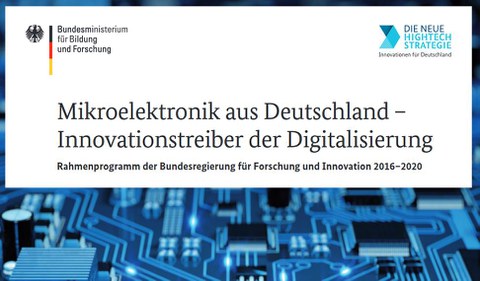Apr 12, 2016
BMBF Research topics in microelectronics 2016-2020
The funding focus will address five technology areas:
Electronic systems with multiple functions
- novel system integration technologies on wafer and subtrat level and their combination for highly integrated, power-optimized and high quality electronic systems
- Heterointegration technologies and device concepts for multifunctional electronic systems which are suitable for example for the integration of various functions and chip technologies and for the integration of heterogeneous systems and in foils
- innovative sensor concepts and their implementation based on semiconductors
- embedding technologies and micro-nano-bonding technologies
- Strategies to optimize and improve packaging technologies and materials for electronic circuits and modules
- innovative testing technology and simulation models for system behavior
- models for the understanding and prediction of technological and functional reliability and long-term stability of highly integrated electronic systems
- production-oriented measuring and testing methods for highly integrated electronic systems
- modularization and standardization of highly integrated electronic systems for variety of different applications
Power electronics for energy efficiency
- novel circuitry solutions for efficient systems on the basis of new power semiconductor materials,
- new approaches to the construction and interconnection technology and thermal management to potential new materials to be used, for example, for higher switching frequencies and other operating temperatures,
- modeling of failure mechanisms and optimize the reliability of component and system level,
- increased networking and system intelligence for highly integrated solutions based on all classes of materials.
Innovative tools for chip and system design
- complex design rules for smaller feature sizes, where physical effects always play a major role, have no effect on larger linewidths,
- inclusion of non-functional aspects such as power consumption, robustness or aging effects,
- highly automated design of "mixed-signal circuits", in which analog components (e.g. wireless communication interface) and digital circuits are integrated into a system,
- inclusion of the construction and connection technology for 3D-integrated, highly compact systems as well,
- Test and verification methods for mixed analog-digital systems and 3D-integrated systems.
- Expansion of the computer-aided design environment across the entire value chain to hedge the whole system at an early stage before the production starts.
Secure chips for the digital society
- Methods for unique identification of chips - for example, by implementing
- physical fingerprints using so-called "Physically nonclonable functions (PUF) "and for the detection, validation predetermined safety level,
- circuitry measures for protecting chips against external attacks and
- the implementation of a manufacturer's authenticity protection, for example to manipulate prevention during production at a contract manufacturer (Foundry).
Electronics production technology and production for the future
- the further automation of production,
- equipment and processes for the high-precision, reliable and cost effective process small and different components to complex electronic and multifunctional components and systems
- measuring and testing technology to support faster innovation cycles and high quality requirements.
Source: Rahmenprogramm der Bundesregierung für Forschung und Innovation 2016-2020

